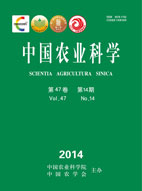-
The Influence of Different Crops Rotation on the Environment of Soil and Physiological Characteristics of Malus hupehensis Rehd. Seedlings
- 吕Yi-1 , SONG Fu-Hai-1, LI Yuan-Yuan-2, SHEN Xiang-1, CHEN Xue-Sen-1, WU Shu-Jing-1, MAO Zhi-Quan-1
-
Scientia Agricultura Sinica. 2014, 47(14):
2830-2839.
doi:10.3864/j.issn.0578-1752.2014.14.013
-
 Abstract
(
512 )
Abstract
(
512 )
 HTML
(
1 )
HTML
(
1 )
 PDF (752KB)
(
873
)
PDF (752KB)
(
873
)
 Save
Save
-
References |
Related Articles |
Metrics
【Objective】Wit the soils of 25 years continuous cropping apple orchard as the object, the influence of different crops rotation on soil environment of continuous cropping apple orchard and physiological indexes of Malus hupehensis Rehd. seedling was studied, then a preferable rotation planting crop was chosen, in order to provide a gist for the prevention and control of apple continuous cropping obstacles.【Method】 Wheat, peanut, alfalfa, shallot, and potato were planted respectively in the soil, which was collected from the old apple orchard and blended evenly, then the soil organic matter, content of available N, P, K, effective Fe , Mn, Cu and Zn, the change of the number of soil bacteria, fungi and actinomycetes, and the change of contents of soil phenolic acids were determined. At the same time, potting M. hupehensis Rehd. seedlings after rotation of different crops. The biomass and root activity, SOD, POD, and CAT enzyme activities of M. hupehensis Rehd. seedlings were determined. 【Result】The content of soil organic matter increased significantly in the crop rotation soil of wheat and shallot when compared with apple continuous cropping soil, and the increments were 48.37% and 36.7%, respectively. Soil organic matter content of potatoes crop rotation and fallowing was reduced by 8.61% and 9.26%, respectively, compared with CK, and potato rotation significantly enhanced the content of available N, P, effective Cu, Fe, and Mn, compared with controls and increased by 217.32%, 217.32%, 240.55%, 91.38% and 158.30%, respectively. Peanut rotation remarkably reduced the content of available potassium, but increased the contents of effective Mn and Fe. Simultaneously rotation with wheat, peanut and shallot increased the number of soil bacteria, inhibited the breeding harmful fungus in the soil. Among them, bacteria amounts of shallot rotation increased by 200%, fungi amount decreased by 44.7%, bacteria amounts of shallot rotation increased by 141.9%, shallot rotation and Wheat rotation enhanced the ratio of bacteria and fungi by 435.8% and 211.1%, respectively. Shallot rotation markedly reduced the content of phenolic acids in the soil by 45.3%, among them, the content of phloridzin decreased by 84.2%. Compared with potato rotation, the content of phenolic acids in shallot rotation decreased by 241.15%, and compared with wheat rotation decreased by 190.07%. Compared with CK, Shallot rotation significantly improved the root SOD, POD, and CAT enzyme activities of M. hupehensis Rehd., and increased by 48.12%, 58.33% and 65.77%, respectively. It could be seen that Shallot rotation significantly increased the ground fresh weight of M. hupehensis Rehd. by 49.7%, underground fresh weight increased by 76.5% compared with CK. Shallot rotation significantly increased the ground fresh weight of M. hupehensis Rehd. by 40.63% compared with peanut rotation, and underground fresh weight increased by 56.84% compared with wheat rotation.【Conclusion】There exist larger differences in the effect of continuous cropping soil environment and root of M. hupehensis Rehd. when rotation cropping with different plants. Shallot rotation can increase the content of soil organic matter, enhance the ratio of bacteria and fungi, reduce the content of phenolic acids in the soil, improve the root enzyme activity of M. hupehensis Rehd., and increase the ground and underground biomass. From the perspective of prevention and control of apple continuous cropping obstacles, rotation shallot is more advantageous to reduce the apple continuous cropping obstacles.









